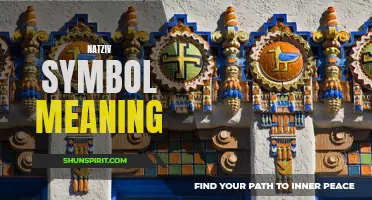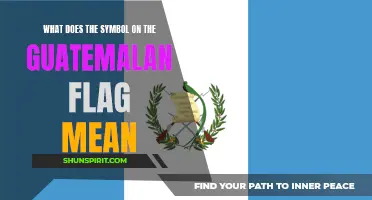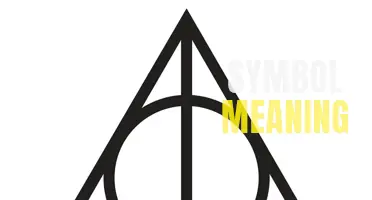
Pride symbols and their meanings hold a significant role in the LGBTQ+ community, serving as powerful tools of unity and empowerment. These symbols not only represent the diverse identities within the community but also act as a beacon of love, acceptance, and resistance against discrimination. From the iconic rainbow flag to symbols like the pink triangle and the transgender pride flag, each symbol represents the unique experiences and struggles faced by different groups within the LGBTQ+ community. By understanding the rich history and symbolism behind these pride symbols, we can appreciate the strength and resilience of the LGBTQ+ community and strive towards a more inclusive and equal society for all.
What You'll Learn
- What are some commonly recognized symbols of pride, and what do they represent?
- How have pride symbols evolved over time, and what new symbols have emerged in recent years?
- Are there any universal pride symbols that are recognized across different cultures and regions?
- How do pride symbols help to foster a sense of community and belonging within the LGBTQ+ community?
- Are there any controversial or debated pride symbols, and what are the different perspectives surrounding them?

What are some commonly recognized symbols of pride, and what do they represent?
Pride is a concept that is deeply ingrained in human nature. It signifies a sense of accomplishment, self-worth, and confidence. Throughout history, various symbols have been used to represent this powerful emotion. These symbols serve as a visual representation of pride and are recognized worldwide. In this article, we will explore some commonly recognized symbols of pride and delve into their meanings.
The rainbow flag is perhaps the most well-known symbol of pride. This flag consists of a spectrum of vibrant colors, usually in the form of horizontal stripes. The rainbow flag initially emerged as a symbol of the LGBTQ+ community's struggle for acceptance and equality. Designed by artist Gilbert Baker in 1978, each color of the flag has its own significance. Red represents life, orange symbolizes healing, yellow stands for sunshine, green represents nature, blue symbolizes harmony, and purple represents spirit. The rainbow flag has since become an emblem of pride and solidarity for not only the LGBTQ+ community but also other marginalized groups.
Another widely recognized symbol of pride is the raised fist. This symbol dates back to the 1960s civil rights movement in the United States and was popularized by the Black Panther Party. The raised fist serves as a symbol of resistance, strength, and unity. It represents the power of collective action and the fight against oppression. Over the years, the raised fist has been adopted by various social justice movements worldwide and has come to symbolize pride in the face of adversity and the determination to create positive change.
The pink triangle is a symbol that holds significant historical meaning. Originally used by the Nazis to mark and persecute LGBTQ+ individuals during the Holocaust, the pink triangle has been reclaimed as a symbol of pride and resilience. It serves as a reminder of the past struggles faced by the LGBTQ+ community, while also representing the progress made in the fight for equality. The pink triangle symbolizes strength, resilience, and a refusal to be silenced or marginalized.
In addition to these specific symbols, there are also universal symbols that represent pride. The peacock is a perfect example of such a symbol. Known for its vibrant and showy plumage, the peacock has long been associated with pride and beauty. Its display of feathers represents an unapologetic expression of one's uniqueness and individuality. The peacock serves as a reminder to embrace and celebrate one's true self, just as the bird proudly displays its feathers.
Symbols of pride play a crucial role in fostering a sense of belonging and unity within communities. They provide a visual representation of shared experiences, struggles, and progress. Whether it is the rainbow flag, the raised fist, the pink triangle, or the peacock, these symbols have become powerful representations of pride and empowerment. They serve as reminders of the strength and resilience of marginalized communities and inspire individuals to be proud of who they are.
Decoding the Symbolic Meaning of the Pink Flamingo
You may want to see also

How have pride symbols evolved over time, and what new symbols have emerged in recent years?
Pride symbols have played a significant role in the LGBTQ+ (Lesbian, Gay, Bisexual, Transgender, Queer) rights movement, serving as powerful expressions of identity, visibility, and solidarity. Over the years, these symbols have undergone changes, and several new symbols have emerged, reflecting the evolving nature of the movement and its growing inclusivity.
One of the most iconic and enduring pride symbols is the rainbow flag. Designed by artist and gay rights activist Gilbert Baker in 1978, the flag is comprised of six-colored stripes, each representing a different aspect of the LGBTQ+ community. The rainbow flag has become widely recognized as a symbol of LGBTQ+ pride and is prominently displayed during pride events around the world.
Another symbol that has evolved alongside the rainbow flag is the pink triangle. Originally used by the Nazis to identify and persecute gay men during World War II, the pink triangle has been reclaimed by the LGBTQ+ community as a symbol of strength and defiance. In recent years, the triangle has been modified to include additional colors, representing other marginalized groups within the LGBTQ+ community, such as lesbians, bisexuals, and transgender individuals.
In addition to these longstanding symbols, several new symbols have emerged in recent years to represent different facets of the LGBTQ+ community. One such symbol is the transgender pride flag, designed by Monica Helms in 1999. The flag consists of five horizontal stripes, with light blue representing transgender men, light pink representing transgender women, and white representing those who are non-binary or questioning their gender identity.
Another notable symbol is the bisexual pride flag, designed by Michael Page in 1998. The flag features three horizontal stripes, with pink representing homosexuality, purple for bisexuality, and blue for heterosexuality. The flag was created to address the unique challenges and experiences faced by bisexual individuals, who often face erasure and discrimination within both the LGBTQ+ community and society at large.
In recent years, there has also been a surge in the use of inclusive pride symbols that aim to reflect the diversity within the LGBTQ+ community. For example, the progress pride flag, designed by Daniel Quasar in 2018, incorporates elements of the transgender pride flag and the Philadelphia pride flag, which includes black and brown stripes to represent LGBTQ+ people of color. The progress pride flag features an arrow-shaped chevron on the left-hand side, symbolizing forward movement and acknowledging the ongoing fight for equality.
Other new symbols include variations of pride flags that specifically represent different racial and ethnic identities within the LGBTQ+ community, such as the pride flag with a black stripe for Black LGBTQ+ individuals and the pride flag with brown and black stripes for LGBTQ+ people of South Asian and Middle Eastern descent.
The evolution and emergence of these pride symbols underscore the ever-changing nature of the LGBTQ+ rights movement. They reflect a growing understanding of intersectionality, recognizing that individuals within the LGBTQ+ community can face multiple forms of discrimination and marginalization based on various aspects of their identity.
As the movement continues to progress and society becomes more inclusive, it is likely that new symbols will continue to emerge, representing the diverse experiences and identities within the LGBTQ+ community. These symbols serve as visual reminders of the enduring struggle for equality and provide a sense of pride and belonging to those who identify as LGBTQ+.
The Deep Symbolism Behind the Rainbow Infinity Symbol
You may want to see also

Are there any universal pride symbols that are recognized across different cultures and regions?
Pride symbols are used to represent the LGBTQ+ community and to show support for their rights and equality. While some symbols are more widely recognized and accepted, the concept of pride and the symbols associated with it can vary across different cultures and regions.
One widely recognized symbol of pride is the rainbow flag. The rainbow flag was first designed by Gilbert Baker in San Francisco in 1978 and has since become synonymous with the LGBTQ+ movement. The flag is made up of six colors, representing diversity and inclusivity. The rainbow flag is now widely recognized in many countries and has become a symbol of pride and support for the LGBTQ+ community.
Another symbol that is commonly associated with pride is the pink triangle. The pink triangle was originally used by the Nazis during World War II to identify and persecute gay men. However, it has since been reclaimed as a symbol of strength and resilience within the LGBTQ+ community. The pink triangle is often used to remember the struggles faced by the community in the past and to promote equality and acceptance.
While the rainbow flag and the pink triangle are widely recognized symbols of pride, it is important to note that different cultures and regions may have their own unique symbols and expressions of pride. For example, in some countries, the national flag may be used as a symbol of LGBTQ+ pride to show solidarity with the community.
In addition to these symbols, pride parades and festivals are also common expressions of LGBTQ+ pride and are often held in cities around the world. These events feature colorful displays, music, and performances that celebrate the diversity and unity of the LGBTQ+ community. Pride parades and festivals provide a platform for people to come together, support one another, and raise awareness about the issues faced by the community.
In conclusion, while the rainbow flag and the pink triangle are widely recognized symbols of pride, there is no single universal pride symbol that is recognized across all cultures and regions. The expressions of pride and the symbols used may vary depending on cultural and regional contexts. However, the underlying message of pride, equality, and acceptance remains the same regardless of the symbols used.
The Intriguing Symbolism behind the Two Triangles Symbol
You may want to see also

How do pride symbols help to foster a sense of community and belonging within the LGBTQ+ community?
Pride symbols, such as the rainbow flag and other LGBTQ+ emblems, play a crucial role in fostering a sense of community and belonging within the LGBTQ+ community. These symbols represent a shared identity and serve as a visual reminder of the progress made and the ongoing fight for LGBTQ+ rights.
One of the most recognizable and widely used pride symbols is the rainbow flag. The flag consists of six colors – red, orange, yellow, green, blue, and violet – each representing different aspects of the LGBTQ+ community. The flag was designed by Gilbert Baker in 1978 and has since become a powerful symbol of pride and solidarity.
By displaying the rainbow flag or other pride symbols, individuals within the LGBTQ+ community are able to identify and connect with one another. This allows for a sense of belonging and creates spaces where LGBTQ+ individuals can feel safe and accepted. Pride symbols act as a visual representation of a community that has traditionally been marginalized and discriminated against. They provide a sense of pride and empowerment, helping to combat the feelings of isolation and self-doubt that may come with being part of a minority group.
Additionally, pride symbols serve as a powerful tool for visibility and awareness. When these symbols are displayed in public spaces, they send a message of inclusivity and acceptance. They can help to normalize LGBTQ+ identities and challenge stereotypes and prejudices. By proudly wearing or displaying pride symbols, LGBTQ+ individuals and their allies can showcase their support for the community and contribute to a more inclusive society.
Another way that pride symbols foster a sense of community and belonging is by providing opportunities for celebration. Pride parades and other events, often marked by abundant displays of rainbow flags and other pride symbols, bring together LGBTQ+ individuals and allies from all walks of life. These events provide a space where everyone can freely express themselves and celebrate their shared identity. They create a sense of unity and solidarity, allowing individuals to feel part of something greater than themselves.
In conclusion, pride symbols are a vital part of the LGBTQ+ community. They help to foster a sense of community and belonging by providing a visual representation of a shared identity. By displaying these symbols, individuals within the LGBTQ+ community can identify and connect with one another, creating spaces where they feel safe and accepted. Pride symbols also serve as a powerful tool for visibility and awareness, challenging stereotypes and prejudices. Additionally, they provide opportunities for celebration and unity. Overall, pride symbols play a crucial role in creating a sense of community and belonging within the LGBTQ+ community and promoting acceptance and inclusivity in society.
The Powerful Symbolism of Vultures: Exploring their Meaning in Different Cultures
You may want to see also

Are there any controversial or debated pride symbols, and what are the different perspectives surrounding them?
Symbols play an important role in the LGBTQ+ community, representing pride, unity, and diversity. However, like any symbols, they can be subject to controversy and debate. In this article, we will explore some of the controversial pride symbols and the different perspectives surrounding them.
Pink Triangle:
The pink triangle was originally used by the Nazis to identify and persecute gay men during World War II. In the 1970s, the LGBTQ+ community reclaimed it as a symbol of pride and remembrance. Some argue that the use of the pink triangle perpetuates the idea that LGBTQ+ individuals are victims or survivors of a tragic past. They believe that using a Nazi symbol undermines the progress made by the community and should be replaced with a more positive symbol. On the other hand, many LGBTQ+ individuals and organizations see the pink triangle as a powerful reminder of the history of oppression and the ongoing struggle for equality.
Black Triangle:
Similar to the pink triangle, the black triangle was used by the Nazis to identify and persecute lesbian women. The black triangle has been reclaimed by some lesbian and feminist groups as a symbol of pride and resistance. However, there are debates within the community regarding the use of the black triangle. Some argue that it is a powerful symbol of lesbian history and invisibility, while others see it as a reminder of the trauma and persecution. It is important to acknowledge and respect these differing perspectives.
Leather Pride Flag:
The Leather Pride Flag, often featuring black and blue stripes, is associated with the leather and BDSM community. Some critics argue that the use of the Leather Pride Flag in pride events could alienate or exclude individuals who are uncomfortable or unfamiliar with BDSM culture. They believe that pride events should be inclusive and focused on broader LGBTQ+ issues. On the other hand, supporters of the Leather Pride Flag argue that pride events are about celebrating the diverse identities within the community, including those who are part of the leather and BDSM community. They advocate for the recognition and acceptance of different LGBTQ+ subcultures.
Transgender Pride Flag:
The transgender pride flag, featuring blue, pink, and white stripes, has gained widespread recognition and acceptance within the LGBTQ+ community. However, there are debates surrounding its design and inclusivity. Some argue that the flag should be redesigned to include additional colors or symbols to represent non-binary individuals and other gender identities. They believe that the current flag is too binary-centric and does not fully reflect the diversity of the transgender community. Others argue that the current flag is already widely recognized and changing it could cause confusion or dilute its impact as a symbol of transgender pride. These debates highlight the ongoing discussions within the community about gender inclusivity and representation.
In conclusion, the LGBTQ+ community is a diverse and complex group, and symbols hold different meanings and perspectives for different individuals. While some pride symbols may be controversial or debated, it is important to engage in respectful dialogues and acknowledge the diverse experiences within the community. Ultimately, the goal should be to create a sense of inclusivity, unity, and pride for all members of the LGBTQ+ community.
Decoding the Hidden Meanings Behind Hollywood's Most Iconic Symbols
You may want to see also



















